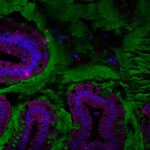Lien vers Pubmed [PMID] – 28090564
Lien DOI – 10.1016/j.jcmgh.2016.04.007
Cell Mol Gastroenterol Hepatol 2016 Sep; 2(5): 584-604
Innate immune dysfunction can promote chronic inflammatory diseases of the liver. For example, mice lacking the flagellin receptor Toll-like receptor 5 (TLR5) show microbial dysbiosis and predisposition to high-fat diet (HFD)-induced hepatic steatosis. The extent to which hepatocytes play a direct role in detecting bacterial products in general, or flagellin in particular, is poorly understood. In the present study, we investigated the role of hepatocyte TLR5 in recognizing flagellin, policing bacteria, and protecting against liver disease.Mice were engineered to lack TLR5 specifically in hepatocytes (TLR5ΔHep) and analyzed relative to sibling controls (TLR5fl/fl). TLR5 messenger RNA levels, responses to exogenous flagellin, elimination of circulating motile bacteria, and susceptibility of liver injury (concanavalin A, carbon tetrachloride, methionine- and choline-deficient diet, and HFD) were measured.TLR5ΔHep expressed similar levels of TLR5 as TLR5fl/fl in all organs examined, except in the liver, which showed a 90% reduction in TLR5 levels, indicating that hepatocytes accounted for the major portion of TLR5 expression in this organ. TLR5ΔHep showed impairment in responding to purified flagellin and clearing flagellated bacteria from the liver. Although TLR5ΔHep mice did not differ markedly from sibling controls in concanavalin A or carbon tetrachloride-induced liver injury models, they showed exacerbated disease in response to a methionine- and choline-deficient diet and HFD. Such predisposition of TLR5ΔHep to diet-induced liver pathology was associated with increased expression of proinflammatory cytokines, which was dependent on the Nod-like-receptor C4 inflammasome and rescued by microbiota ablation.Hepatocyte TLR5 plays a critical role in protecting liver against circulating gut bacteria and against diet-induced liver disease.


